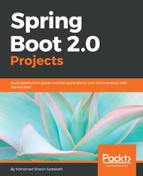Spring Boot is an application development framework for the Java virtual machine (JVM) that enables users to write stand-alone, production-grade, flexible, and extensible Spring-based applications with minimum code and configurations. This follows the Rapid application development (RAD) paradigm where the focus is on writing business logic that matters. With the introduction of cloud-based hosting services and microservice architectures, Spring Boot has been further elevated into a must-know technology platform. The following are some of its features:
- Standalone: A Spring Boot application is self-contained and easily deployable. It can start with its own embedded Tomcat, Jetty, Undertow web container, or as a console application from a just standard file such as Java Archive (JAR) or Web Archive (WAR). An example of this would be an application that has spring-boot-starter-web as a dependency, which when run will by default inside an embedded Tomcat web container.
- Production-grade: A Spring Boot application enables most of the features required for production, such as monitoring, connection pools, externalized configurations, and so on, out of the box, and ships with industry-standard, time-tested, and proven third-party applications such as Tomcat.
- Flexible: A Spring Boot application will have most of its settings auto-configured with default settings based on the dependencies available in the classpath of the application. But the auto-configuration will step back whenever a custom configuration is made. An example for this would be when a Spring Boot application finds a MySQL JDBC driver in the classpath; it auto-configures DataSource, which connects to the host localhost and port 3306, as those will be the settings for a MySQL Server with a default installation.
- Extensible: A Spring Boot application will have most core functionalities implemented out of the box, but also has a lot of Service Provider Interfaces (SPI), which are used by third-party developers to implement or modify functionality. An example of this would be when a requirement arises for a custom endpoint in Spring Boot Actuator; extending and overriding the AbstractEndpoint.invoke method in a Spring Bean will expose it as a new endpoint under Spring Boot Actuator.
Spring Boot does not do any code generation and does not require any XML files to be configured in order to run. Spring Boot is ideal for on-premise and cloud-based deployments with a quick boot-up time and a good memory footprint. The uniqueness of Spring Boot comes from its ecosystem of Spring modules, which covers security, data persistence, batch processing, and so on and from the highly active, competent community of developers who keep on improving the Spring Boot Framework.
